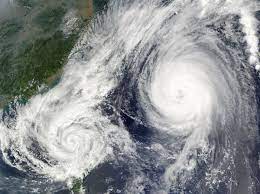Fujiwhara Effect:

Powerful winds tormented the Bay Area and other parts of Central and Southern California, uprooting trees and disrupting the power supply due to the Fujiwhara effect.
- Fujiwhara effect was identified by a Japanese meteorologist, Sakuhei Fujiwhara.
- It was observed for the first time over the western Pacific Ocean when typhoons Marie and Kathy merged in 1964.
- When two hurricanes (or cyclones), spinning in the same direction, are brought close together, they begin ‘an intense dance around their common centre’ – this interaction between two cyclones is called the Fujiwhara effect.
- It Occurs If one hurricane’s intensity overpowers the other, then the smaller one will orbit it and eventually crash into its vortex to be absorbed.
- On the other hand, if two storms of similar strengths pass by each other, they may gravitate towards each other until they reach a common centre and merge or merely spin each other around for a while before shooting off on their own paths.
- The two ‘dancing’ cyclones, if they are intense enough, may merge with one another, leading to the formation of a mega cyclone capable of wreaking havoc along coastlines.




